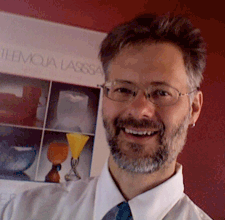Pilgrim Reindeer in Pisa, 1348
a free multimedia novel by
Thomas A. DuBois, University of Wisconsin-Madison
 |
Pilgrim Reindeer in Pisa, 1348 a free multimedia novel by Thomas A. DuBois, University of Wisconsin-Madison |
|
|
|
1. Part I Setting Out 23. The Miracle [October 6 , 1347]
I wanted to make sure to portray the German-speaking population of Reval in a way that did not depict them as cruel invaders or merciless persecutors of the native Estonian populace. Like Hildegard here, the people of Reval were usually merchant families whose menfolk spent all or part of the year carrying on trade between the various Hanseatic churches. Hildegard is a kind person and she treats Bávlos with respect and appreciation.
I also wanted to illustrate the way in which accounts of miraculous cures spread in the medieval world. People were intensely interested in receiving divine assistance when faced with difficulties in life: disease, loss of luck, or hardship of any sort. They prayed to saints represented by statues, and if they found their prayers answered, they gave thanks not only to the saint (and God) but also to the statue that had served as the recipient of their prayers. Thus statues could become the objects of fervent, enthusiastic devotion, and a statue that had proved efficacious for one person could expect to meet with new petitioners very soon thereafter. Such a spreading of reputation would be aided, of course, if the person who received the miraculous cure was a person of substance, whose testimony was widely respected or trusted in the community. So it is that Hildegard's account of her granddaughter's miraculous healing spreads rapidly among her friends and neighbors, quickly extending beyond Reval through the trading networks of the Hanseatic world. Church authorities were often hard pressed to investigate and appraise miracle reports before they had spread far and wide in this manner and devotions could rise in a matter of days or weeks.
You may notice in the chapter that the mechanism by which the statue becomes efficacious is not entirely clear. On the Christian side, Bávlos appeals to the Virgin Mary, and the cult of the sacred milk was becoming very popular among German-speaking Christians in the 1340s. On the pre-Christian side, however, Bávlos croons a joik when taking leave of the statue, and it remains unclear which supernatural agency he regards as primary in the miracle(s) which occur. Certainly the joik's call of a blessing upon the maker of the statue could help explain how Master Claes's arthritis is cured when Bávlos returns to Gotland.
This chapter ends the first third of the novel. When next you read of Bávlos, he will have reached Lübeck and begin his long trek across Central Europe on his way to Italy.